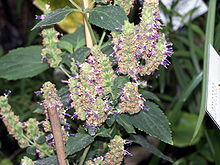Patchouli
| Patchouli | |
|---|---|

| |
| Scientific classification | |
| Kingdom: | Plantae |
| Clade: | Tracheophytes |
| Clade: | Angiosperms |
| Clade: | Eudicots |
| Clade: | Asterids |
| Order: | Lamiales |
| Family: | Lamiaceae |
| Genus: | Pogostemon |
| Species: | P. cablin
|
| Binomial name | |
| Pogostemon cablin (Blanco) Benth.
| |
| Synonyms | |
|
Nilam, Patchouly | |
Patchouli reaching up to 75 centimetres (2.5 ft) in height and bearing small, pale, pink-white flowers.
It is native to the island region of Southeast Asia, including Sri Lanka, Indonesia, the Malay Peninsula, New Guinea, and the Philippines. It is also found in many parts of North East India.[1] Noted for its fragrant essential oil, it has many commercial uses and is now extensively cultivated in tropical climates around the world, especially in Asia, Madagascar, South America, and the Caribbean. Indonesia currently produces over 90% of the global volume of patchouli oil (~1,600 metric tons).
Etymology
The word derives from the Tamil patchai (Tamil: பச்சை) or paccuḷi, meaning "green", and ellai (Tamil: இலை), meaning "leaf".[2][3]
Cultivation
Patchouli grows well in warm to tropical climates. It thrives in hot, humid weather but not extended periods of direct sunlight. If the plant withers due to lack of water, it tends to recover quickly after rain or watering. Although rare, the
Essential oil

Extraction
Extraction of patchouli's essential oil is by steam distillation of the dried leaves[4] and twigs,[5] requiring rupture of its cell walls by steam scalding, light fermentation, or drying. The main chemical component of patchouli oil is patchoulol, a sesquiterpene alcohol.[6]
Leaves and twigs may be harvested several times a year. Some sources say the highest quality oil is produced from fresh, share dried biomass distilled close to where they are harvested;[7] others say that boiling the dried leaves and fermenting them for a period of time is best.[8]
Components
Uses
The heavy, strong, woody, and earthy scent of patchouli has been used for centuries in
Pogostemon cablin, P. heyneanus and P. plectranthoides are all cultivated for their essential oil, known as patchouli oil. Although there are some sub-varieties, the most common commercial varieties are native to the islands of Sumatra and Sulawesi in Indonesia.
Perfume
Patchouli oil is used widely in modern
Insect repellent
One study suggests that patchouli oil may serve as an all-purpose insect repellent.
Incense
Patchouli is an important ingredient in East Asian incense. Both patchouli oil and incense underwent a surge in popularity in the 1960s and 1970s in the US and Europe, mainly as a result of the hippie movement of those decades.[17]
Culinary
Patchouli leaves have been used to make a herbal tea. In some cultures, the leaves are eaten as a vegetable or used as a seasoning. There are also several herbal medicines, both in Indonesia and in China (TCM), that include dry, ground patchouli leaves as one of the key ingredients.
Toys
In 1985, American toy manufacturer Mattel used patchouli oil in the plastic used to produce the action figure Stinkor in the Masters of the Universe line of toys.[18]
Notes
- ^ Also spelled patchouly or pachouli.
References
- ^ "Pogostemon cablin (Blanco) Benth". Plants Of the World Online.
- ^ "Patchouli". Online Etymology Dictionary. Retrieved 10 December 2011.
- ^ "patchouli". Merriam Webster Dictionary. 17 February 2024.
- ^ "PATCHOULI OIL: Overview, Uses, Side Effects, Precautions, Interactions, Dosing and Reviews". www.webmd.com. Retrieved 15 November 2022.
- ^ "Extraction of Patchouli Essential Oil by Steam Distillation Process". Sumatrans Patchouli Essential Oil. Archived from the original on 2 October 2016.
- ^ "22 Amazing Benefits of Patchouli Essential Oil : Uses, How to Use, Side Effects, DIY (2022)". gyalabs.com. Retrieved 26 April 2022.
- ^ Grieve, Maude (1995) A Modern Herbal [1]. 2007
- ^ Leung A, Foster S Encyclopedia of common natural ingredients used in food, drugs and cosmetics John Wiley and Sons 1996
- ISSN 0882-5734.
- ISSN 0882-5734.
- PMID 19424449.
- ^ S2CID 94104732.
- ^ Ballentine, Sandra (5 November 2010). "Vain Glorious | Sex in a Bottle". Tmagazine.blogs.nytimes.com. Retrieved 10 December 2011.
- ^ a b "What is Patchouli?". wisegeek.com. 18 February 2024.
- S2CID 23425671.
- PMID 14705881.
- ISBN 978-0-7922-3666-5.
- ^ Stinkor: Masters of the Universe
